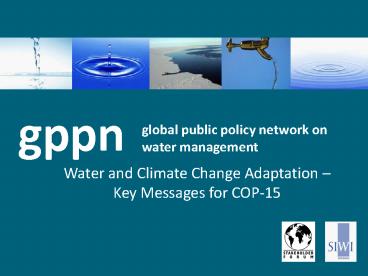global public policy network on water management - PowerPoint PPT Presentation
1 / 10
Title:
global public policy network on water management
Description:
gppn global public policy network on water management Water and Climate Change Adaptation Key Messages for COP-15 GPPN Background joint initiative of Stakeholder ... – PowerPoint PPT presentation
Number of Views:187
Avg rating:3.0/5.0
Title: global public policy network on water management
1
global public policy network on water management
gppn
- Water and Climate Change Adaptation Key
Messages for COP-15
2
GPPN Backgroundjoint initiative of
Stakeholder Forum and Stockholm International
Water Instituteto consult and work with global
stakeholders on priorities for the global water
and sanitation agenda, and help communicate those
priorities to decision-makerskey focus in 2009
on building broad stakeholder participation on
water and climate change issues ahead of
COP-15
3
Multi-stakeholder Initiative
- Consulted broad range of stakeholders on water
and climate change across Major Groups,
including - Farmers
- Trade Unions
- Women
- Science and Technology
- Local Authorities
- NGOs
- Business
- Youth
- Indigenous Peoples
- Also includes UN agencies.
4
Key Messages
- Problems/Issues
- Climate change adaptation IS water adaptation
- Water and its availability and quality will be
the main pressures on, and issues for, societies
and the environment under climate change - Climate change impacts on water resources will
present obstacles to achieving the MDGs, due to
reduced water availability, flooding, lower food
production and extreme weather events. - Adaptation must address the water sector as a
priority
5
- Good Governance
- Develop national and cross-sectoral Climate
Change Adaptation Plans with Water Management as
a cross-cutting consideration system wide
approach with water as central. - Strengthen institutional capacity to integrate
climate change adaptation into existing water
management plans and policies - Empower local communities and stakeholders to
participate in water resources planning and
management for climate change adaptation scale
up local coping strategies and techniques, build
on traditional knowledge. - Strengthen mechanisms for effective transboundary
water management arrangements build capacity for
agreeing legal frameworks, recognise role of UN
Watercourses Convention, re-negotiate existing
transboundary water management agreements.
6
Effective Water Management
- Integrated Water Resources Management provides
good framework for adapting to climate impacts on
water resources. - Institute effective demand-management measures
including efficiency-enhancing technologies
across all sectors, incentives for efficient
water-usage, increased storage capacity - Take an ecosystem approach Adaptation planning
must integrate the preservation and restoration
of ecosystems as part of an investment in natural
and environmental infrastructure for climate
resilience. Natural ecosystems must be recognized
as water customers in their own right.. - Address future uncertainty to avoid
Maladaptation avoid measures that lead to
enhanced water supply in the short term, but
increased water consumption or maladaptation in
the long-term
7
- Information, Observation, Monitoring and Impact
Assessment - Invest in improved meteorological information,
systematic observation and forecasting services
enhance collection of localised data enhance
capacity for data analysis and transfer relevant
technology for doing so. - Enhance availability of and access to data Make
existing data more widely available, especially
to poor and vulnerable communities Share
hydrological data in and among regions in
accordance with WMO Resolution 25 on free and
open exchange of hydrological data. - Identify Hotspots Regional, country and
community level vulnerability hotspots must be
identified so that resources might be channelled
accordingly. Further assessment must also be made
to identify priority countries and communities.
8
- Fair and Equitable Finance
- Funding for Climate Change Adaptation must be new
and additional to Official Development Assistance
(ODA) - Integrate and Mainstream Climate Change
Adaptation into Existing Funds for Water
Management integrate climate change adaptation
into existing funding streams for water
management. Consider adaptive water management as
a priority for other water-reliant sectors. - Prioritize water sector in Adaptation Funding
The UNFCCC Adaptation Fund should prioritise
water management for the spending of funds for
climate change adaptation. - Create a well-governed and coherent adaptation
architecture define roles and responsibilities
of various funds .
9
- Way Forward for COP-15
- Develop (online) resource to promote information
sharing among diversity of initiatives, provide
updates on COP-15 process, information on
negotiations and entry points for water and
climate change adaptation. - Convene workshop prior to June Bonn Meeting, with
negotiators and stakeholders focussing on Water
and Climate Change Adaptation including Danish
Initiative - Co-ordinate strategy meetings on water and
climate change at COP-15 and related preparatory
meetings - Seek co-ordination among stakeholders on
development of draft text for negotiations. - Generate sense of water community at COP-15
10
Thank you! Hannah Stoddart GPPN
Secretariat hstoddart_at_stakeholderforum.org http/
/gppn.stakeholderforum.org































